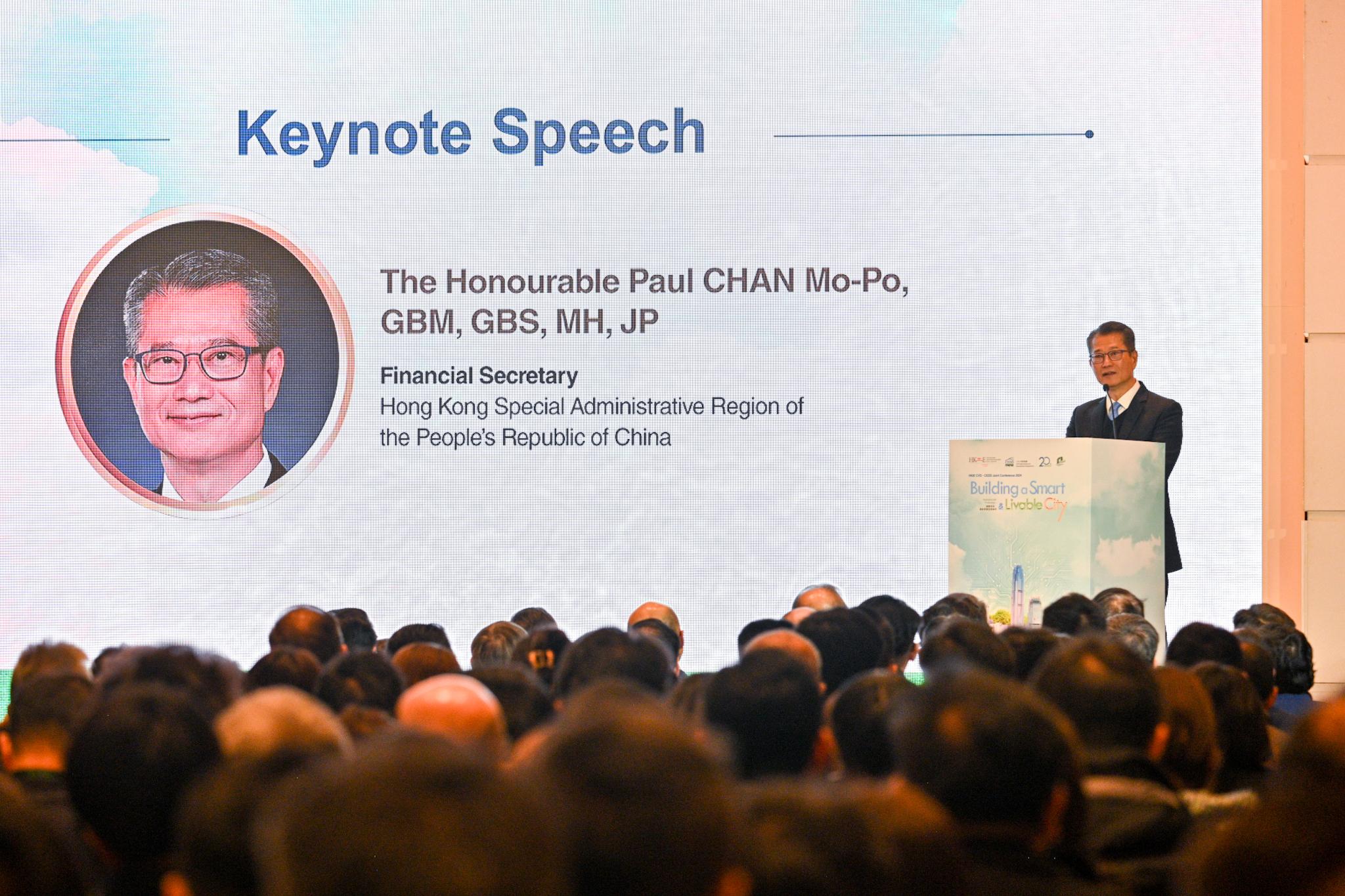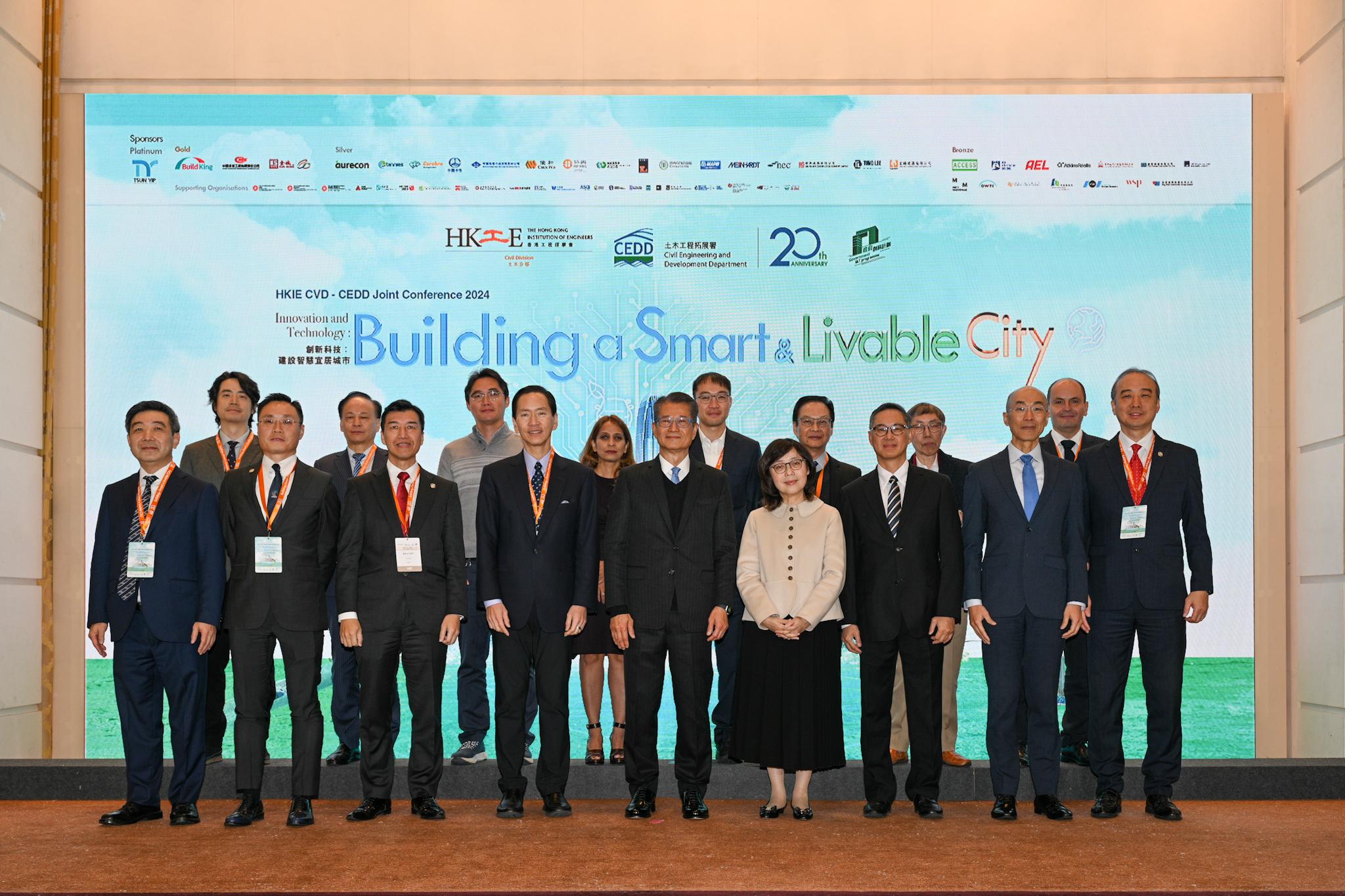Speech by FS at Innovation and Technology: Building a Smart and Livable City Conference 2024 (English only)(with photos)
******************************************************************************************
Bernard (Chairman of M Plus Museum Limited, Chairman of Tai Kwun Culture & Arts Co Ltd and Vice Chairman of Board of the West Kowloon Cultural District Authority, Mr Bernard Chan), Barry (President of the Hong Kong Institution of Engineers, Dr Barry Lee), Simon (Chairman of the Hong Kong Institution of Engineers Civil Division, Mr Simon Ng), Bernadette (Secretary for Development, Ms Bernadette Linn), Ricky (Permanent Secretary for Development, Mr Ricky Lau), Michael (Director of Civil Engineering and Development, Mr Michael Fong), ladies and gentlemen, builders of Hong Kong all,
Good morning. I'm pleased to join you all for today's conference.
First of all, let me take this opportunity to thank the Hong Kong Institution of Engineers and the CEDD (Civil Engineering and Development Department) for organising this joint conference, and my sincere congratulations to the CEDD as you mark your 20th anniversary this year.
The conference today centres on building a smart and livable city with the use of innovation and technology. I know that Bernadette will, in a few minutes, share with you some of the Government's initiatives and developments in this regard. Allow me to take this occasion to focus on a critical aspect of a smart and livable city, that is infrastructure development.
Continuously investing in infrastructure
I am sure everyone here would agree that the Government and the community as a whole need to make a continuous investment in infrastructure. On the one hand, it brings direct benefits by creating jobs, improving the living environment and enhancing the quality of life for our people. On the other, it enables Hong Kong to better integrate into the Greater Bay Area development, which is very important to our long-term social and economic development.
The prerequisite for our sustainable economic and social development is sufficient land supply. Therefore, despite short-term ups and downs in the property market, we need to continue to invest in land creation. We should not forget the lesson that had been learnt the hard way in the past: when we stopped creating land, we ended up creating land shortages.
And infrastructure provision is critical in this city's "infrastructure-led" and "capacity-creating" approach in spatial planning. It will also help us unleash the development potential of areas along major transport infrastructure.
Last month, we unveiled the Hong Kong Major Transport Infrastructure Development Blueprint. It laid out a comprehensive framework for the city's transport infrastructure development, including strategic railways and major road networks for the next 20 years.
The question then is how we are going to implement all the projects? There are a few things that we need to pay attention to.
First, we will need to suitably prioritise these projects. A prime consideration is to rationalise the cash flow requirements in the overall context of the Government's Budget. Another consideration is of course the capacity of the construction industry, to avoid over-concentration of works that would drive up labour, materials and construction costs in general.
Second, cost control and value for money. This is key to earn public support for the projects. I am glad to note that in recent years, the Government is doing generally well in ensuring that public works projects are completed on time and within budget. In the past 10 legislative years since 2013/14, more than 530 Category A projects were completed, with an actual total expenditure of around HK$153 billion, which was 11 per cent lower than the total approved expenditure at HK$172 billion. Colleagues, thank you for your hard and good work.
Yet, there is more that requires our attention. When we talk about cost, we would not only look at the project cost, but also costs in the whole asset life cycle of a project, including management and maintenance.
Third, about financing. For the coming huge investments in infrastructure projects, it is obvious that we could not all count on the Government's capital works expenditure. We need to work with the private sector to leverage market capital.
Borrowing is one option. Since the launch of the Government Green Bond Programme in 2018, we have raised about HK$190 billion in green bonds. The funds have been used to finance 72 public works projects.
At the end of March last year, government debt was at only about 4.5 per cent of our gross domestic product (GDP). Even counting the HK$65 billion in green and infrastructure bonds that we plan to issue in the next few years, the government debt-to-GDP ratio by 2027/28, will still remain below 10 per cent. That's very low by international standards. And we will continue to stick to strict financial discipline, i.e. the funds raised would not be used for meeting recurrent expenditure needs.
Apart from borrowing, we should contemplate different financing arrangements creatively so as to maximise the benefits to the community. We have had some well-known successful cases. For example, railway plus property development, and build-operate-transfer models. Going forward, there may be some other forms of public-private partnerships such as collaboration with long-term investment funds.
To that end, I am chairing the Committee on the Financing of Major Development Projects. The Committee is tasked with examining financing arrangements for major development projects, advising on feasible investment and financing options and evaluating the impact of major development projects on government finances. It held its first meeting last month.
Supporting innovation in construction
Ladies and gentlemen, coming back to the construction industry, I wish to stress the Government's commitment to supporting innovation in construction. Bernadette is going to give you a detailed account in her speech. Allow me just to outline the initiatives in this respect in the last Budget.
First, the Building Testing and Research Institute, the first of its kind in Hong Kong, will get going this year. It will engage in R&D (research and development) for innovative materials, construction methods and technologies. It will also contribute to devising standards, conduct testing and provide accreditation.
It is our vision that the Institute will make good use of Hong Kong's unique advantages as an international platform, facilitating our country's construction standards and related products to converge with those in the international market.
Second, we have substantially completed the study on the first advanced construction industry building in Tsing Yi. The building will provide space for operators to set up steel reinforcement bar prefabrication and other advanced manufacturing yards, as well as processing sites for MiMEP (Multi-trade Integrated Mechanical, Electrical and Plumbing). Construction of the building will proceed soon in the next phase.
Third, we are taking active steps to strengthen the supply chain of MiC (Modular Integrated Construction) modules. A steering committee has been set up by the Development Bureau. They are working very hard in this regard.
Meanwhile, we also see a clear case for more collaboration between the public sector, private sector and academia in smarter and greener construction and infrastructure. Our research capability is strong. In fact, many research teams and start-ups engaged in smart and green technology have been offering competitive products and solutions which are selling well in overseas markets. For example, a City University team has developed a coating for building exteriors that can reduce indoor temperatures by six to eight degrees Celsius. Another startup in Science Park is engaged in underwater carbon-sequestration projects. Their products are now used in Southeast Asia and the Middle East. Indeed, many such local inventions are being used by our works departments.
Concluding remarks
Ladies and gentlemen, I hope I have given you some updates about our continuous commitment to investing in infrastructure and building a smart and livable city. I look forward to the insights from the many expert speakers participating in the conference today.
In just over two weeks we will celebrate Chinese New Year - the Year of the Dragon. This year's Dragon promises to usher in a year of opportunity and promise. Allow me to wish each and every one of you a healthy and rewarding year. Thank you.
Ends/Wednesday, January 24, 2024
Issued at HKT 13:39
Issued at HKT 13:39
NNNN




